We need your consent to use the individual data so that you can see information about your interests, among other things. Click "OK" to give your consent.
ASTM D7276-08
Standard Guide for Analysis and Interpretation of Test Data for Articulating Concrete Block (ACB) Revetment Systems in Open Channel Flow
STANDARD published on 1.8.2008
The information about the standard:
Designation standards: ASTM D7276-08
Note: WITHDRAWN
Publication date standards: 1.8.2008
SKU: NS-38062
The number of pages: 9
Approximate weight : 27 g (0.06 lbs)
Country: American technical standard
Category: Technical standards ASTM
The category - similar standards:
Annotation of standard text ASTM D7276-08 :
Keywords:
articulating concrete blocks, channel stability, erosion, erosion control, open channel flow, overtopping, revetment, ICS Number Code 91.100.30 (Concrete and concrete products)
Additional information
| Significance and Use | ||||||||||
|
This standard is intended for use by researchers and designers to assess the stability of articulating concrete block (ACB) revetment systems in order to achieve stable hydraulic performance under the erosive force of flowing water. An articulating concrete block system is comprised of a matrix of individual concrete blocks placed together to form an erosion-resistant revetment with specific hydraulic performance characteristics. The system includes a filter layer compatible with the subsoil which allows infiltration and exfiltration to occur while providing particle retention. The filter layer may be comprised of a geotextile, properly graded granular media, or both. The blocks within the matrix shall be dense and durable, and the matrix shall be flexible and porous. Articulating concrete block systems are used to provide erosion protection to underlying soil materials from the forces of flowing water. The term “articulating,” as used in this standard, implies the ability of individual blocks of the system to conform to changes in the subgrade while remaining interconnected by virtue of block interlock or additional system components such as cables, ropes, geotextiles, geogrids, or other connecting devices, or combinations thereof. The definition of articulating concrete block systems does not distinguish between interlocking and non-interlocking block geometries, between cable-tied and non-cable-tied systems, between vegetated and non-vegetated systems or between methods of manufacturing or placement. This standard does not specify size restrictions for individual block units. Block systems are available in either open-cell or closed-cell varieties. |
||||||||||
| 1. Scope | ||||||||||
|
1.1 The purpose of this guide is to provide recommended guidelines for the analysis and interpretation of hydraulic test data for articulating concrete block (ACB) revetment systems under steep slope, high velocity flow conditions in a rectangular open channel. Data from tests performed under controlled laboratory conditions are used to quantify stability performance of ACB systems under hydraulic loading. This guide is intended to be used in conjunction with Test Method D 7277. 1.2 This guide offers an organized collection of information or a series of options and does not recommend a specific course of action. This document cannot replace education or experience and should be used in conjunction with professional judgment. Not all aspects of this guide may be applicable in all circumstances. This ASTM standard is not intended to represent or replace the standard of care by which adequacy of a given professional service must be judged, nor can this document be applied without considerations of a project’s many unique aspects. The word “Standard” in the title of this document means only that the document has been approved through the ASTM consensus process. 1.3 The values stated in inch-pound units are to be regarded as standard. The values given in parentheses are mathematical conversions to SI units that are provided for information only and are not considered standard. 1.4 This standard does not purport to address all of the safety concerns, if any, associated with its use. It is the responsibility of the user of this standard to establish appropriate safety and health practices and determine the applicability of regulatory limitations prior to use. |
||||||||||
| 2. Referenced Documents | ||||||||||
|
Similar standards:
Historical
1.4.2014
Historical
15.12.2011
Historical
1.6.2011
Historical
15.12.2008
Historical
1.9.2011
Historical
1.10.2009
We recommend:
Updating of laws
Do you want to be sure about the validity of used regulations?
We offer you a solution so that you could use valid and updated legislative regulations.
Would you like to get more information? Look at this page.



 ASTM C1621/C1621M-14..
ASTM C1621/C1621M-14.. ASTM C1623-11
ASTM C1623-11 ASTM C1634-11
ASTM C1634-11 ASTM C1646/C1646M-08..
ASTM C1646/C1646M-08.. ASTM C1677-11a
ASTM C1677-11a ASTM C1686-09
ASTM C1686-09
 Cookies
Cookies
